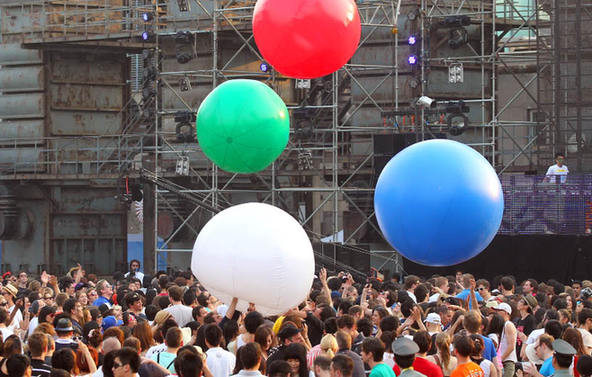| Creative Capital
By WANG ZHI & HOU RUILI
 |
| Intro 2010 Beijing Electronic Music Festival held at 751 D. Park on May 22. Uncredited photos by China Foto Press |
BEIJING is a city that's been under construction for 3,000 years, enjoyed 850 years as a capital and 500 years' exposure to the outside world. The imperial culture and common folklore co-exist, and the culture of the ancient capital mixes with its multi-cultural modernity to give it a unique character. Now, Beijing steps into the post-industrial age, and the husks of industrial architecture remain, ripe for creative re-purposing and offering new horizons for the development of the cultural and creative industry.
The term "creative industry" refers to economic activities based on the use of knowledge to transform original or exclusive content into tangible products or intellectual or artistic services with high economic value for target markets. The creative industry has formed large and diverse fields to handle relations between different creative activities and their outputs, including traditional handicrafts, publications, music, visual and performing arts, as well as technology-intensive and service-oriented types such as film, radio and television, new media and design. The industry has a flexible and standard market structure, including individual artists, small commercial enterprises, and world-renowned transnational companies.
Du Lala is a bestselling novel whose private publisher gambled on a first run of 430,000 copies – and won big time. Its derivatives, including film, television drama and related advertisements, have created a value chain of at least RMB 340 million. Even though the global performance market is shrinking, Beijing's stages are doing exceptionally brisk business, attracting many foreign performing troupes to put on shows here.
Pioneering hub of Beijing's fine arts industry "798," fashion industry engine "751," model of Beijing tourism Shichahai, industrial design thinktank "DRC," and the cultural and entertainment zones of western Beijing are the city's signature cultural repositories where many kinds of creative passion are pooled.
The "Silicon Valley of China" in Haidian District, by virtue of its advantage in concentrating sci-tech talent, houses the "Dream Team" of the cultural and creative industry, having such big-name players as Baidu, Lenovo, and Aigo. The CBD Media Zone in eastern Beijing is the neighborhood for 80 percent of all overseas news agencies stationed in Beijing. The 1919 Creative Park, after occupying its new quarters in the renovated Institute of Biological Research, will become a frontier for film, television, modern stage plays and traditional dramas.
In recent years, creative industry zones have mushroomed in Beijing. In the near future, Jiukeshu Modern Music Zone in Tongzhou District, Cable Eight Creative Park in Chaoyang District, and the Cultural and Creative Park of Renmin University of China will add yet more luster to Beijing. By the end of November 2010, Beijing had 30 such city-level creative zones, and more than 100 district-level creative zones. In the past five years, the added-value margin of the cultural and creative industry has increased from RMB 57.3 billion to RMB 149.77 billion, and its proportion of local GDP went from 9.5 percent to 12.6 percent, making it the second largest industry after the financial sector and a "new engine" of the local economy.
Economic studies show that when the Engel's coefficient drops to under 50 percent and per capita GDP exceeds US $3,000, the proportion of cultural consumption to total consumption will surpass 30-40 percent, and the creative industry will seize a larger market share, becoming a whole new economic growth point. Beijing's Engel's coefficient is 32.4 percent, and its per capita GDP has surpassed US $10,000, which signals that the creative industry is the strategic choice for industrial upgrading and changes in the economic growth pattern. It is also critical to qualitative achievements in urban maturity that befit an important world capital.
|
